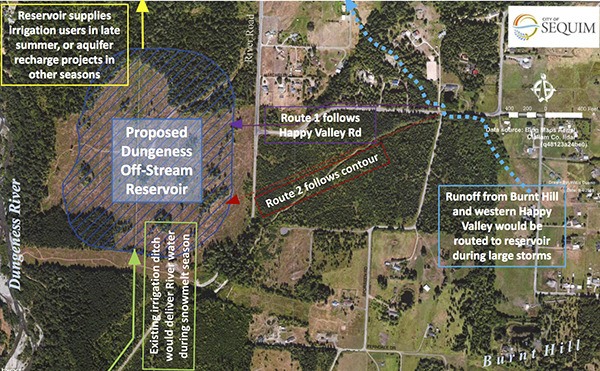Like most Washington cities Sequim was greatly impacted by the 2015 statewide drought and was among the first three regions declared drought stricken — yet, Sequim also experienced a record wet and warm year.
Annual precipitation in Sequim jumped from its usual 16-17 inches to 23.07 inches, according to a 1980-2015 data set from Western Regional Climate Center.
Record rainfall and drought conditions don’t seem compatible, but when increased temperatures keep precipitation from freezing, it can have a significant impact.
State officials declared drought on the Olympic Peninsula on March 13, when the snow water equivalent was at zero percent of its median at the Dungeness SNOTEL station, according to Natural Resources Conservation Service. The Dungeness SNOTEL station is one of four fully automated weather stations (SNOTEL) scattered among the Olympic Mountains used to gather data.
“The drought was due to low snowpack,” Ann Soule, City of Sequim water resource specialist, said. “Summer snowmelt directly affects water supplies in streams and aquifers.”
The average annual temperature of 2015 was 50.97 degrees, Soule said — nearly one degree warmer than the next warmest year within the past 35 years.
Although the 2015 annual precipitation well exceeded the typical amount of annual rainfall in Sequim, much of the rain came after a warm, dry summer.
During December, Sequim received more than 6 inches of rain, Soule reports, breaking yet another record for monthly rainfall since 1980.
Weather spurs future planning
The onset of precipitation late in 2015 recharged the flow of the Dungeness River, which had dropped throughout the summer given the lack of snowmelt and the diversion of water from its channel by Sequim-Dungeness Valley irrigators from April 15-Sept. 15.
Although the rainfall brought relief from the drought, it also puts strain on the drainage system for the City of Sequim.
After and during storm events, stormwater runoff from the western Happy Valley area and Burnt Hill flows toward the city, entering a maze of irrigation ditches, pipes and canals, including Bell Creek.
“It really becomes a problem because so much of the runoff does eventually end up in Bell Creek and Bell Creek can just not handle it,” David Garlington, City of Sequim public works director, said. “It (Bell Creek) traverses the entire city from the southwest corner to the northeast corner so there are multiple opportunities for it to be a headache for the city and residents of the city.”
In areas where there’s a high water table, like Falcon Road, for example, located southwest of Sequim, Soule said those areas “can’t take on too much more water after we’ve had enough rain in the fall.”
“Every time a house goes up on Burnt Hill probably exacerbates this because there’s such a slope and impervious surfaces combined with slopes just generates tons of water,” she said. “I think the amount of water is only going to go up coming from development on Burnt Hill.”
Already, flooding occurs throughout the city when the drainage system reaches its capacity. For example, Soule said, stormwater often overflows in three different places in Carrie Blake Park, covering a lot of the park area.
To better manage stormwater, provide water storage for irrigation and thus divert less water from the Dungeness River when its flow is low, local and state water managers and stakeholders are pursuing an off-stream reservoir. Partners include officials with the Clallam Conservation District, Washington Water Trust, Department of Ecology, Department of Natural Resources, Department of Fish and Wildlife, Jamestown S’Klallam Tribe, Dungeness Water Users Association, Clallam County and City of Sequim.
A proposed reservoir site, owned by the Department of Natural Resources off River Road, has been identified and preliminary planning efforts are underway.
Based on several design options the reservoir could range from 32-88 surface acres, with storage capacities from 550 to 1,586-acre feet.
“To me the significance of that is it’s enough water to avoid diverting Dungeness River water for more than a month,” Soule said.
The concept of a reservoir would be to divert early summer snowmelt from the nearby Dungeness River via existing irrigation canals, as well as capture stormwater runoff. Beyond providing a water supply for irrigators, reducing stormwater stress on the City of Sequim, the proposed reservoir could benefit fish, wildlife, provide recreational and infiltration opportunities.
“We received a letter back from DRN indicating they were supportive of the concept,” Amanda Cronin, project manager with Washington Water Trust.
DNR officials also indicated interest in doing a land exchange for timberland of comparable value, Garlington said. Early project cost estimates range from $20-$40 million.
To help apply for potential funding and show possible partners, engineers with an environmental consulting firm Anchor QEA of Seattle is developing a formal proposal on the reservoir project, Cronin said. However, given the scope and costs of the project, Cronin predicts a long road ahead with no set timeline just yet.
“I do think the unprecedented drought is catalyst for driving new ideas like this,” she said. “2015 gave us a look at what conditions could look like in the future with climate change.”



